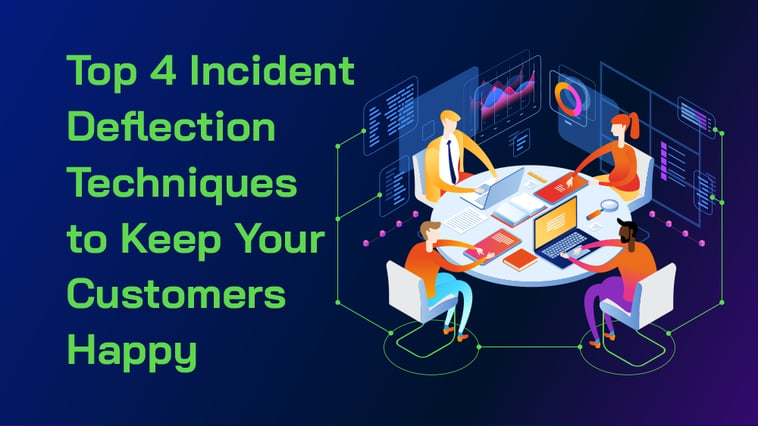Top 4 Incident Deflection Techniques to Keep Your Customers Happy
Consider this scenario:
You have a new checking account and want to transfer money from your primary account to this new one. Fortunately, your first bank allows money transfer to an outside account using Zelle.
You need three pieces of information to make the transfer:
- The name of the bank
- The bank's routing number
- Your account number

You know the name of your new bank, and you can Google the routing number—so that's not a problem. But what's your account number? You check your new bank's website and navigate to the frequently-asked-questions (FAQ) section to figure out where to look. Nothing. You then spend five minutes tapping tabs on the app you downloaded on your phone. No account number. You go into Settings. No dice.
You then call customer service and wait on hold for 25 minutes. Once you finally get someone to talk to, they ask for… your account number! You explain that's why you're calling. So they put you through a two-step verification process, which takes another two minutes. As soon as your identity's verified, they tell you how to find your account number in the app.
By the time you get the information you need, you've spent 35 minutes wrangling with the bank and its app. How do you feel?
The Importance of IRT and FCR in Customer Service
It would have been nice if your new bank had an FAQ that told you how to find your account number. But it took far too long to resolve your incident because it didn't. The bank's incident response time (IRT)—also incident resolution time—was below expectations.
But that wasn't the only reason behind your frustration. Your issue wasn't resolved at first contact when you checked the bank's FAQ. Because it contained no helpful information on finding your account number, the bank could not provide what's referred to as a first contact resolution (FCR).
Top 4 Techniques for Deflecting Incidents
IRT and FCR are important metrics because they directly correlate with customer satisfaction. One of the best ways to minimize IRT and increase FCR is through incident deflection. These techniques provide customers with resources that enable them to resolve issues quickly and during their first contact with your organization.
1. FAQ
Your FAQ section can be a one-stop-shop for customers experiencing common issues. Remember that the term "frequently asked questions" is a misnomer. Even if none of your customers have asked what may be a common question yet, you should include it in your FAQ.
So if you run a manufacturing company that produces electronic components, the time it takes to manufacture and ship an item depends on the item ordered. Instead of forcing customers to call and ask when an order will be ready, include an FAQ for each component category to help them estimate when their products will be ready.
2. Knowledgebase
You can think of a knowledgebase as a multi-volume encyclopedia that covers all of your products or services, as well as issues related to each. This allows customers to understand your solution and various tangential topics comprehensively.
In addition to comprehensive information, your knowledgebase should have:
-
- A search bar
- Topics arranged by categories
- Links to applicable FAQs
- A "Contact Support" button so customers can reach out to a representative at any time
3. Virtual Agent
A virtual agent, also called a "chatbot," answers a range of common questions and addresses specific issues. It follows a combination of rules that automatically provides customers with answers based on keywords and phrases. Some use artificial intelligence (AI) and natural language processing (NLP) to discern what a customer is asking and the best information to provide.
A virtual agent can answer a broad set of queries depending on the rules you set up. It can serve as the first and last stop for customers reaching out for help if configured properly.
4. Robust Catalog of Products or Services
A robust product or service catalog provides a complete list of the products or services you offer and drills down into the details. For example, a service catalog for the IT segment of your organization outlines all IT-related services the department delivers for internal staff and external customers.
Often, customers simply need to understand better what you offer before committing to a purchase. This is where a carefully planned catalog really shines. It can help decision-makers confirm your solution is what they need.
Bolster Incident Deflection with GSI
Regardless of the incident deflection techniques you plan to employ to help customers resolve issues on their own, ServiceNow ITSM provides the necessary infrastructure to get you up and going. It can support the creation and maintenance of FAQs, a knowledgebase, virtual agents, and product/service catalogs, as well as track relevant metrics so you can identify which technique works best for which situation.
GSI’s ServiceNow experts have extensive experience and knowledge implementing various incident deflection programs that meet customers where they are. To learn more about how GSI can support your customer service goals using ServiceNow, reach out to us today.
